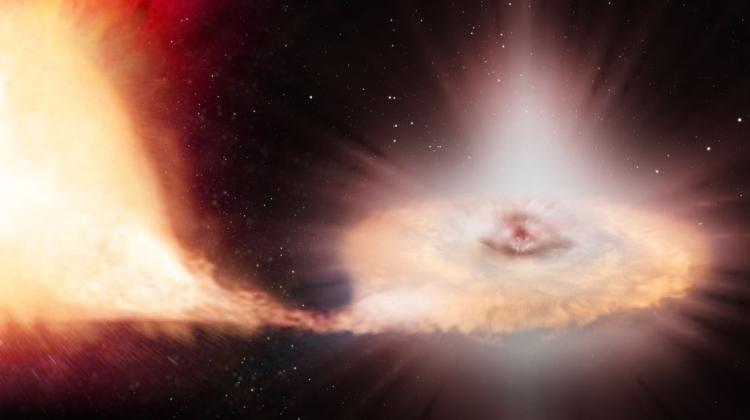Gaia Observatory discovered its first supernova

Gaia Observatory discovered its first supernova, reported the University of Warsaw Astronomical Observatory, whose astronomer was a co-discoverer of the supernova.
The object, designated Gaia14aaa, appeared in an inconspicuous galaxy about 500 million light years from Earth.
The Gaia Observatory was launched into space by the European Space Agency (ESA) in December 2013. On July 25, 2014 the observatory began to systematically scan the sky as part of its main scientific objective, determining the positions of billion stars. This process will continue for five years.
But constantly scanning the sky and returning to the same point every often is also an opportunity to discover objects the appearance of which in a particular place at a certain time no one can predict, for example, supernova explosions.
Dr. Łukasz Wyrzykowski of the University of Warsaw Astronomical Observatory, co-discoverer of the supernova Gaia14aaa, points to the astronomical significance of this type of observations: "Such observations are extremely valuable to astronomers because they allow us to detect changing objects. In this case, we saw brightening associated with the death of a star".
Polish scientist is working in the Gaia Science Alert Team of astronomers from Warsaw, Cambridge and other European centers, who study variable objects. On September 9-12, many of them met at an international conference in Warsaw to discuss the first results of the Gaia mission.
The fact that we are dealing with the explosion of a supernova, has been confirmed by ground-based observatories, including the Isaac Newton Telescope on La Palma and the Astronomical Observatory of the University of Warsaw in Ostrowik (Mazowieckie). The proof is the presence in the spectrum of the object of spectral lines of iron and other elements occurring in supernova explosions.
In addition, the blue portion of the spectrum is brighter than the red, which means that it is probably a Type Ia supernova, and a little bit more can be said about the configuration of the object before the explosion. It was a binary system consisting of a white dwarf and a star with a smaller mass. White dwarf pulled the matter from the other star, until it crossed the limit, beyond which it became unstable and exploded.
PAP - Nauka w Polsce
cza/ agt/
tr. RL
Przed dodaniem komentarza prosimy o zapoznanie z Regulaminem forum serwisu Nauka w Polsce.















